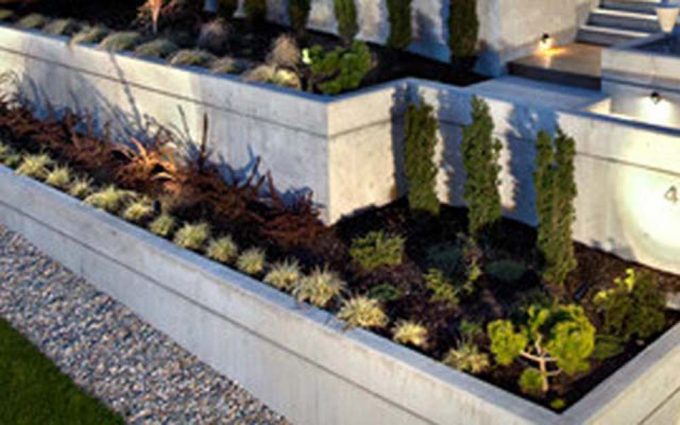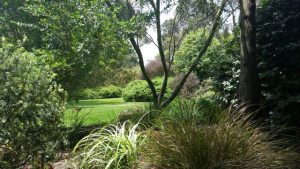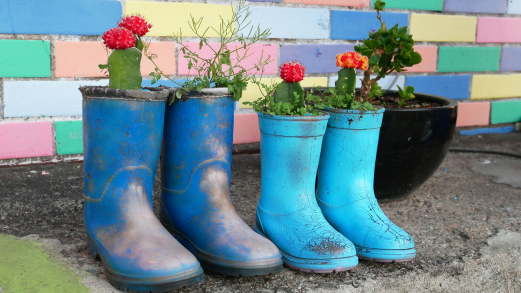Did you know that the environmental impacts of concrete are out of control and that the carbon dioxide produced from the production of concrete are a close second to fossil fuel emissions? Did you also know that concrete is the second most consumed substance on earth after water?
Alison Aplin, award winning landscape designer (Winner 2014, 2016 Landscaping Victoria ‘The Sustainable Landscape’) tells why she refuses to use concrete.
How is this relevant to gardens?
“As a sustainable landscape designer, designing and implementing gardens for over 20 years, I believe that it is time that we considered the massive environmental impacts that many landscape designers are causing through the use of concrete. It is composed primarily of cement – a powdery substance derived from the process called calcination where calcium carbonate decomposes to form calcium oxide with the release of carbon dioxide. Concrete is formed when cement is mixed with clay, water, sand and gravel.
 Cement manufacturing is highly energy – and emissions – intensive because of the extreme heat required for its production from calcium carbonate. The energy used comes largely by burning coal and gas which converts the energy stored in them to heat with the release of carbon dioxide. The first law of thermodynamics states that energy can be transformed from one form to another, but is unable to be created or destroyed. So further concrete production requires use of more and more of declining resources of coal and gas and that cannot continue indefinitely.
Cement manufacturing is highly energy – and emissions – intensive because of the extreme heat required for its production from calcium carbonate. The energy used comes largely by burning coal and gas which converts the energy stored in them to heat with the release of carbon dioxide. The first law of thermodynamics states that energy can be transformed from one form to another, but is unable to be created or destroyed. So further concrete production requires use of more and more of declining resources of coal and gas and that cannot continue indefinitely.
Concrete is used throughout the building industry for homes and commercial premises. It is the most widely used building material because of its strength in many situations. So if this use continues, then the external element, within gardens, needs to be considered. Is its outside use appropriate?
Because of my strong ethic, I refuse to provide rendered retaining walls in gardens, especially on flat sites, so that the site can be significantly modified in order to take the plants that the designer wants to grow. This is not how it should be done.
Sustainable gardens last for a reason, whereas so many gardens with modification to the site i.e. rendered walled gardens with fancy paving over concrete bases, are not the way to go. The plants in these gardens often collapse after a few years because of the site has been completely changed from its natural condition. This is strongly atypical of a normal garden – it is not clever garden design. But this approach of landscape architects and landscape designers is becoming the norm. I firmly believe that because of the massive increase in concrete use, this practice needs to be controlled now.
What can we do about it?
 The right way to design a garden, and this is my opinion, is to suit the plant to the site and soil as in my garden on the right. Not modify the soil to suit the plant that you want to grow. It’s the same as a person wanting to grow camellias where they have alkaline soil. The naïve will try to change the pH of the soil by adding sulphur or peat – this is a very slow process. Why not put the camellia in a pot where the soil can be regulated properly? And then put a plant in the ground that is suited to that position – and it should thrive!
The right way to design a garden, and this is my opinion, is to suit the plant to the site and soil as in my garden on the right. Not modify the soil to suit the plant that you want to grow. It’s the same as a person wanting to grow camellias where they have alkaline soil. The naïve will try to change the pH of the soil by adding sulphur or peat – this is a very slow process. Why not put the camellia in a pot where the soil can be regulated properly? And then put a plant in the ground that is suited to that position – and it should thrive!
According to the Concise Oxford Dictionary, a ‘garden’ is ‘a piece of ground devoted to growing flowers, fruit or vegetables’. There is no mention of rendered, raised planter boxes or concrete en masse. A garden is about plants.
As a designer there are so many more sustainable alternatives to concrete – it’s just a matter of changing direction and taking the client with you. If you have a passion, and confidence in what you are talking about, the client will respect the advice when sustainable alternatives are suggested and the reasons explained. This conversation needs to start – with the landscape architect, landscape designer and the general public requesting gardens that are composed of concrete.
We all really need to start becoming more aware of the excessive use of concrete. And it is excessive. We need to start the conversation with others about this worldwide problem – it has to stop. We are all now fully aware of the impacts of fossil fuels, with the exception of those who lack any capacity for common-sense, so we need to make the world more aware of the effects of concrete. It is a major global problem that, in my opinion, needs addressing now.”
Alison Aplin, Timandra Design & Landscaping
Related Articles:
Citizen Science: A Pathway to Gardening Success and Biodiversity Conservation
In recent years, the realm of science has experienced a remarkable transformation, one that invites people from all walks of life to participate…
A Sustainable Gardener’s Guide to Thrifty Gardening
Creating an eco-friendly and cost-effective garden involves more than just nurturing plants; it's about adopting a sustainable approach that…




